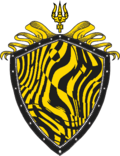Garis Hati Gelap: Difference between revisions
mNo edit summary |
|||
| Line 11: | Line 11: | ||
| demonym = Garishati | | demonym = Garishati | ||
| timezone = UTC-10 | | timezone = UTC-10 | ||
}}'''Garis Hati Gelap''' ('''がりしゃち''' in [[Bahasa Sokoku]]) is a member state of Sokoku, located mainly on the island with the same name (Garis Hati) off the south coast of Altaia. It was formed in 76XX when the | }}'''Garis Hati Gelap''' ('''がりしゃち''' in [[Bahasa Sokoku]]) is a member state of [[Sokoku]], located mainly on the island with the same name (Garis Hati) off the south coast of [[Altaia]]. It was formed in 76XX when the [[Livaria]]<nowiki/>n colony XX was declared decolonised and a part of Sokoku. It is the second most populous state and second largest in area within the federation. | ||
== Etymology == | == Etymology == | ||
Garis Hati Gelap literally means "dark heart line" or "dark jaw line" depending on the region. It refers to a pre-colonial indigenous belief where a | Garis Hati Gelap literally means "dark heart line" or "dark jaw line" depending on the region. It refers to a pre-colonial indigenous belief where a person's character and thus fate was defined by the palm lines and wrinkles around the mouth and eyes. This practice remained commonplace even when the island's several regions converted to Lizehanist belief systems in the 66th-68th centuries. As such, the island inhabitants were referred to as "the people of the heart lines" (''orang-orang dari garis hati'') which gradually evolved in the common name for the island used by outsiders. | ||
During the decolonisation wars, the local opposition to the colonial status started using the name "Garis Hati" as a badge of honor, with the addition "Gelap" referring to the armed branch of the decolonisation movement. Up to today, the island is called "Garis Hati" while the state is called "Garis Hati Gelap", but both are used almost as synonyms. | During the decolonisation wars, the local opposition to the colonial status started using the name "Garis Hati" as a badge of honor, with the addition "Gelap" referring to the armed branch of the decolonisation movement. Up to today, the island is called "Garis Hati" while the state is called "Garis Hati Gelap", but both are used almost as synonyms. | ||
Revision as of 04:23, 1 November 2023
 |
 |

| |
| Country | Sokoku |
|---|---|
| Capital | Mengakui |
| Area | 435,025 km2 km2 |
| Population | 34M |
| Density | 78 per km2/km2 |
| Demonym | Garishati |
| Time zone | UTC-10 |
Garis Hati Gelap (がりしゃち in Bahasa Sokoku) is a member state of Sokoku, located mainly on the island with the same name (Garis Hati) off the south coast of Altaia. It was formed in 76XX when the Livarian colony XX was declared decolonised and a part of Sokoku. It is the second most populous state and second largest in area within the federation.
Etymology
Garis Hati Gelap literally means "dark heart line" or "dark jaw line" depending on the region. It refers to a pre-colonial indigenous belief where a person's character and thus fate was defined by the palm lines and wrinkles around the mouth and eyes. This practice remained commonplace even when the island's several regions converted to Lizehanist belief systems in the 66th-68th centuries. As such, the island inhabitants were referred to as "the people of the heart lines" (orang-orang dari garis hati) which gradually evolved in the common name for the island used by outsiders.
During the decolonisation wars, the local opposition to the colonial status started using the name "Garis Hati" as a badge of honor, with the addition "Gelap" referring to the armed branch of the decolonisation movement. Up to today, the island is called "Garis Hati" while the state is called "Garis Hati Gelap", but both are used almost as synonyms.
History
Pre-colonisation
Establishment of colonial rule
Decolonisation process
Demographics
Geography, landscape, climate and nature
Culture
Since the inclusion into Sokoku, the internal tension between diifferent tribes, regions, cultures and ethnicities has decreased a lot. Where the Livarian colonisers used the differences between the Garishatis to assert their power, the different groups have found a way to co-exist. The use of Bahaso as a way of communicating between the different regional dialects and language varieties has been quite helpful, since communication now could take place in a way that didn't imply one party having to adapt to the other, both had to compromise.
The regional languages of Garis Hati have the least in common with Bahaso, despite its proximity to Shuuen which has been the cornerstone of the language. Even Bahaso can sound quite different, for example the Garishati's themselves tend to name their state gar-SHA-ti with three syllables and the sh~ sound, while the standard prononciatinon is GA-ris-HA-ti with four syllables and without the sh~ sound.
One common cultural outing is the Striped Jaguar, which is used in the state's coat of arms. Garishatis take pride in the survival of the unusual cat into modern times. This pride is shown in emblems, wall paintings, art etc. as prevalent cultural outing.
Garis Hati has a distinct branch of Guso called Menguap meaning "yawn" or "emptiness", which dates back to the decolonisation period. Menguap is generally seen as the opposite side of Gelap, the mental side of the independence movement opposed to the armed brance. Both sides and attitudes were needed to liberate Garis Hati and start building a common future.